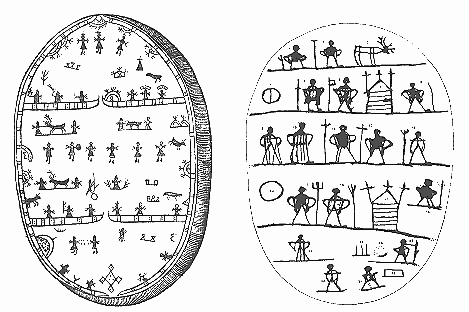

|
Front page Vision and Standards Contents - Finnish Witch Trials - The Wage of Sin is Death Links Contact |
THE WITCH DRUM, NOITARUMPU
© Timo Kervinen

Picture: Otava Picture Archives
A shaman used the witch drum not only as a musical instrument, but also as a magical device, which he implemented in order to induce himself into a mystical "trance", and to seek wisdom only obtainable far beyond the realm of day-to-day reality. By singing and drumming he was able to reach the proper mood and feeling, preparing himself for a journey into the Underworld (Manala or Tuonela in Finnish). During the trance he could communicate with the souls of the dead who dwelled in the Manala, presenting them with questions, for example, about the reasons of sickness, future events, and advice for whatever the community and its members would require for their good and well-being.
Minister Samuel Rheen was aware that the drum helped the shaman to:
- gain knowledge of events taking place elsewhere - even in locations at very great distances;
- find out whether plans for the future will succeed or not, and whether illness will strike among the people;
- discover ways to cure the sick, and
- to acquire wisdom as to what sort of offering would please the gods or demons, and what kind of animal should be killed as a sacrifice.
The witch drum or "Lappish drum", as it was also referred to, was made of wood and skin. It was painted with diverse symbols which were utilised for various purposes. On some drums there were symbols representing different places, or events like hunting excursions. On others - the newer ones - there were also depictions of Heaven with angels, and of Hell with the devil. When uncovering future events by drumming, a small tool, arpa (a die) danced on the drumhead and moved from one figure to another. On that basis the diagnosis was made. The movements of the die could also be used to force the spirits or demons to submit to what the shaman had ordered.
In the 17th and 18th centuries shaman drums in Finland were destroyed
by the clergy. Not a single drum is known to have survived. However, in
Sweden some original drums can be seen in Nordiska Museet (The
National Museum of Cultural History) in Stockholm.
